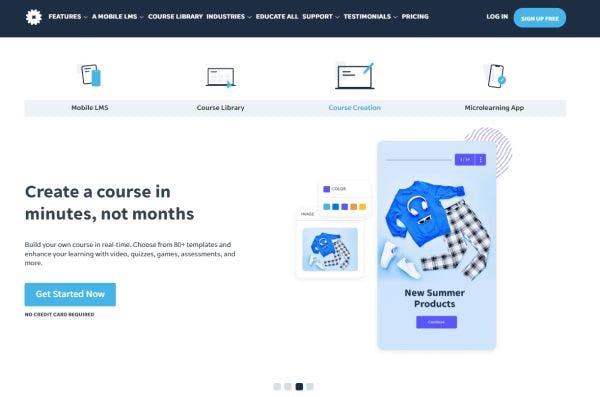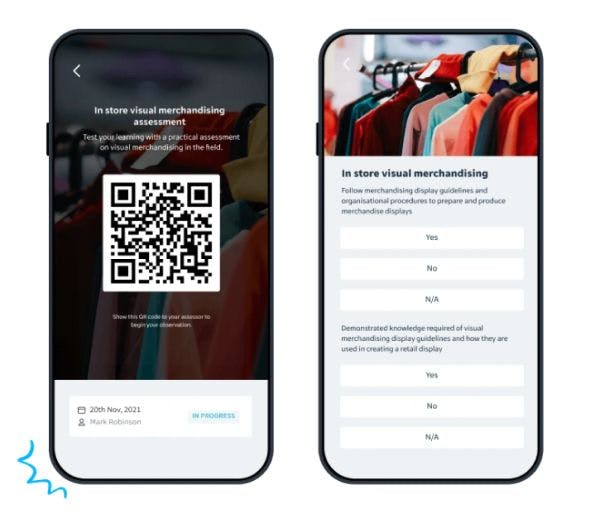10 Hybrid Learning Benefits

If there’s one thing that COVID-19 has shown us over these years, it’s that it’s possible to train learners both in-person and online – and even more so in a hybrid learning environment that combines the two. Let’s take a look at the many hybrid learning benefits and discover why it’s such a popular training method today.
1. Better engagement
Hybrid learning leads to higher engagement, mostly because it combines both online and traditional learning and development methods, adapting to everyone’s learning preferences. Traditional learning would force everyone to attend an instructor-led training (ILT) or in-person class session, which basically discourages self-directed learners from fully engaging. But with this type of training, they’re given the option to attend online and learn at their own pace. When they’re in control of their learning method, the possibility of them engaging is much higher.

There are also more opportunities to improve the engagement of your training initiatives with hybrid learning. The face-to-face element of hybrid learning lets you plan fun activities like role-play scenarios, FAQ sessions, and polling. As for its online aspect, you can gamify your training materials and even add game-like elements for a more fun and exciting learning experience.
Setting up a hybrid training or flipped classroom course may seem quite tricky and time-consuming, but not if you have a hybrid learning tool that can lend you a hand. Kickstart your hybrid learning with EdApp, an award-winning LMS platform jam-packed with user-friendly tools that can take away all the fuss of organizing hybrid training and learning programs. At its core, you’ll find a free content authoring tool that can help you build an online course without any learning curve. You can even reinforce gamification strategies and learning activities like leaderboards, reward systems, timers, and scores, so learning feels less of a burden and much more like a fun activity!

Even the ILT component of hybrid learning works with EdApp. Through its Virtual Classroom feature, you can organize in-app video sessions with your favorite video conferencing platforms like Zoom and Microsoft Teams.

Sign up for free and start using the best hybrid learning platform today!
2. More flexible schedule
Adding to these hybrid learning benefits is that it’s also more flexible than the traditional in-person learning method, and this benefit applies to both the educators and the trainee. It’s not all the time that the learners are able to attend their classes – they may be physically unwell, while some may be running late because of their scheduling conflicts. Luckily, with hybrid learning, they can still attend virtually, or simply retake the lessons that are available online. Not to mention, scheduling trainers in multiple locations can become a headache when they're traveling around the city for lessons, be sure to take into account their calendar availability and drive times. All they need is a laptop, computer, or mobile phone to attend their training.

As for the trainer’s side, hybrid learning makes it easier to monitor your learners and make sure that they have the knowledge and skills to perform their tasks correctly. This form of learning involves the use of hybrid training tools, which are mostly equipped with automated assessment features that can help you assess your team’s skills without a fuss.
Take EdApp’s Practical Assessment feature as an example. Through its drag-and-drop form builder, you can easily create a checklist-style assessment and quizzes that you can use when conducting an in-person assessment. To access these practical assessments, all you need to do is scan your team member’s QR code. From there, easily mark off items, leave comments, and pass/fail your trainee – all in real-time. The best part? All the results are automatically tracked in the admin portal, giving you no stress in verifying their competency level!

3. Higher retention rate
There’s no one-size-fits-all approach to learning. Some learners thrive on self-paced learning from the comfort of their homes, while others are much more productive when learning in-person with their peers. This is why hybrid learning is so popular – it gives learners the freedom to engage with their course materials and learn on their own terms, whether online or in-person. As a result, learners are able to participate more in the training and retain information at a much higher rate.

What’s more is that since learners are not constrained to online or in-person training, they can benefit from both learning approaches. Being in online classes allows them to focus on areas that they find challenging and skip the topics they already know. And with the help of in-person lectures, they can apply everything they’ve learned into practice. Combining these two activities improves learning retention, boosting the success of your training.
4. Better employee well-being
Allowing your learners to decide on a learning process that best suits them will dramatically improve their well-being by a great margin. If they’re not too motivated to come into the office, they can simply attend virtually and from the comfort of their home. This aspect of hybrid learning allows your team to have a healthy work/life balance. If they would prefer to attend their training in-person, they may also do so. With the company of their peers, they’re able to build stronger collaboration and also have fun while learning.

5. Cost-effective learning
Teaching and learning in a hybrid set up is also more economical as compared to its traditional counterpart. Giving your employees the option to attend their training online helps reduce the expenses that you would gain from organizing in-person training, from renting a huge venue to flying your people to your training location. Most of the activities and materials will be turned digital as well, which is a more cost-efficient solution than printing hundreds of copies and distributing them to everyone. You can even make changes and updates on the spot without reprinting anything.

Shifting to digital learning is also more economical for your learners as they will no longer have to travel to the office for their training. The time away from work will be reduced as well, since they will be traveling less.
6. Better learning support
In-person training lets your team participate in group exercises and practice their collaboration skills with their peers. Sure, that’s great, but the catch is that it’s unlikely for them to be able to communicate with their trainers during their training sessions. But with hybrid learning, they’ll have the freedom to ask any questions they may have with their trainers. They can even send them a chat or email to get the feedback they need. This gives them far better learning support than simply sticking to traditional classroom training.

7. Reduced stress and anxiety
While often overlooked, hybrid learning can help reduce any stress and anxiety that some of your learners may experience in either an online or face-to-face learning environment. For others, online learning amplifies the feeling of loneliness and isolation. For this reason, they’re more inclined to attend training and activities that are done in person. Meanwhile, some learners feel more secure and confident in learning and reaching out to their peers in a digital space than in a classroom.

Instead of choosing between the two learning formats, hybrid learning gives you and your learners the best of both worlds. They may opt to join a face-to-face training, although they can also attend online. Giving your learners the power to decide on how to learn and socialize on their own terms reduces all the discomfort and pressure brought on by being limited to just a single learning process.
8. Higher training participation
Given that hybrid learning is more flexible and engaging than most other learning methods, it’s not surprising that it also yields a higher participation rate. The virtual aspect of hybrid learning is the best option for those who live too far from the training site since they can participate conveniently from the comfort of their own home.

It’s also great for learners who are always on the go, like sales reps, marketing professionals, and gig workers. If they’re not able to attend in-person, they can still participate virtually in your training sessions or take the eLearning-formatted courses like cyber security training, fire safety, first aid training, or HAZCOM training.
9. Improved communication skills
Communication is a core skill in almost every industry. But with the advancement of technology and remote working, being adept at face-to-face communication is no longer sufficient. It’s now also essential that your team is proficient in virtual communication. Each training activity that they complete as part of their hybrid learning will help develop and refine both of their virtual and in-person communication abilities. They’ll learn how to share their ideas and express their thoughts with their teams and allow collaboration efforts to push through, whether they’re in the same room or not.

What’s more, is that your team will also get to practice how to communicate via email, chat, or video conferencing apps. These hybrid activities will get them ready for future client and customer communications or workplace collaboration projects.
10. Widespread accessibility
Another powerful hybrid learning benefit is that it makes your training initiative more accessible for your learners. This is especially beneficial if you’re handling teams that are dispersed all over the globe. With hybrid learning, you can organize training and workshops without the need for your teams to show up in person. This, in turn, gives your remote employees a chance to still participate in your training and learn alongside their colleagues, even though they’re in a distant location.

Learners will also find it much easier to access their course materials since they will be stored online. Traditionally, they would need to attend their training sessions or approach their trainers to get a copy of these materials. But with hybrid learning, all they need is access to the database so they can easily revisit their lessons whenever needed.
Author
Jeanellie Avelino
Jen is a learning expert at EdApp, a mobile-based training platform that helps corporates and businesses bring their training solutions to the next level. She carries an extensive writing experience in a variety of fields, including architecture, the gig economy, and computer software. Outside of work, she enjoys her free time watching her favorite series and documentaries, reading motivational books, and cross-stitching.
